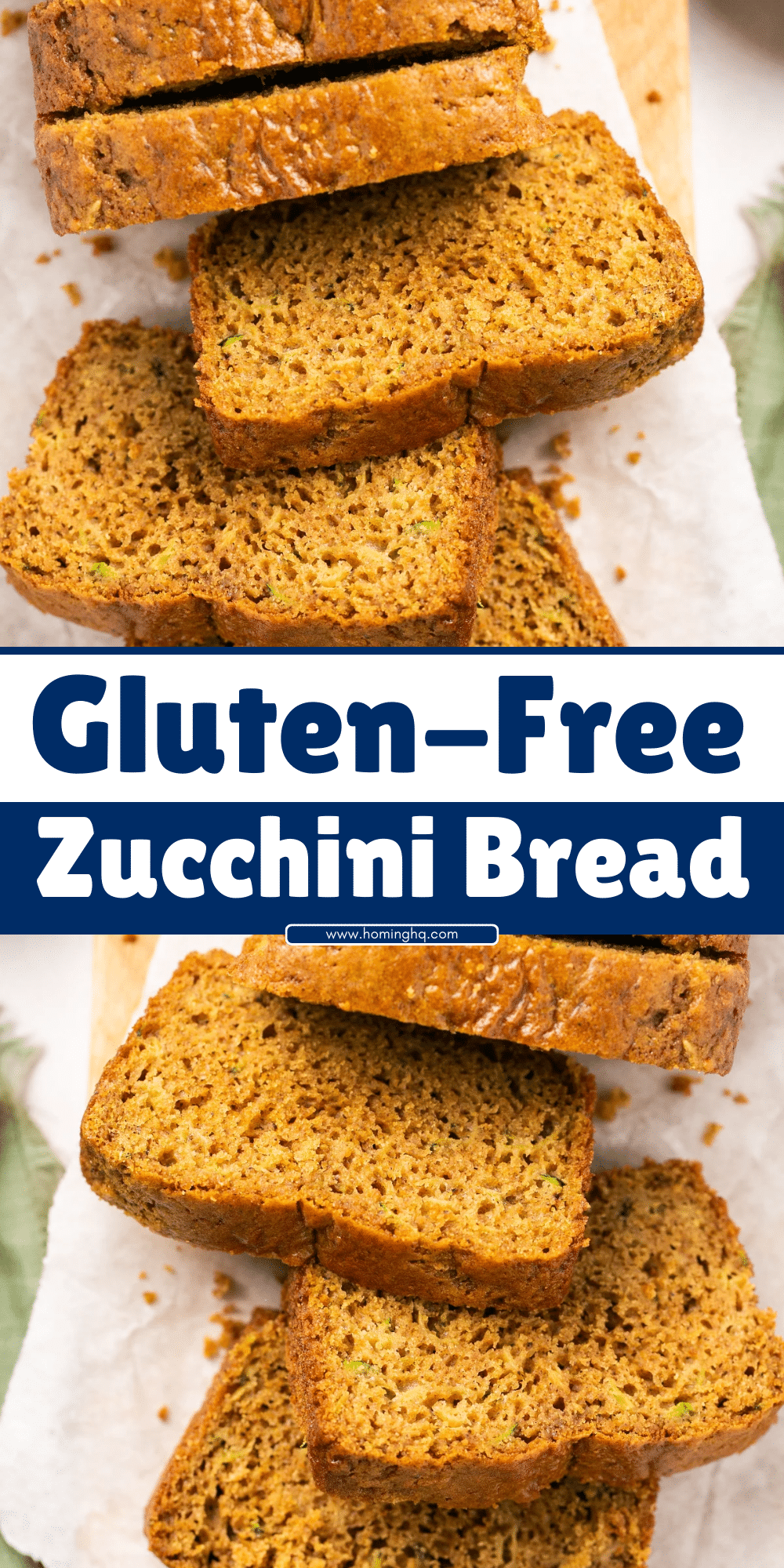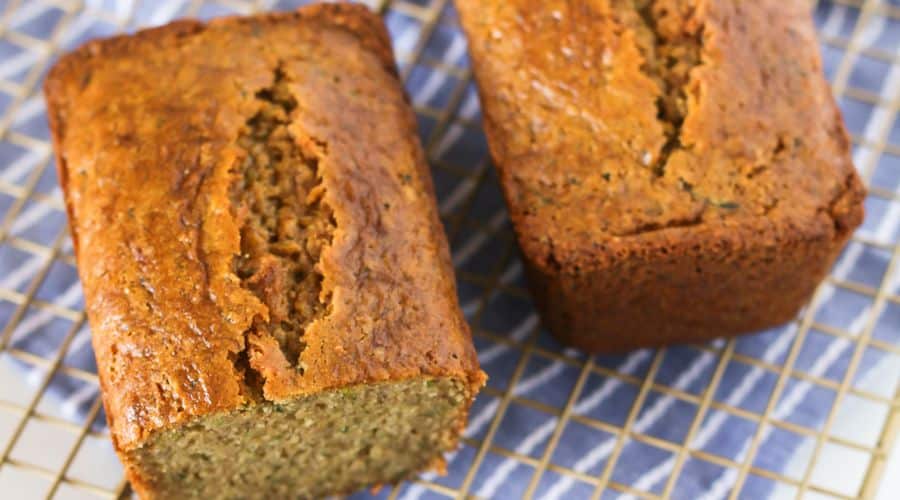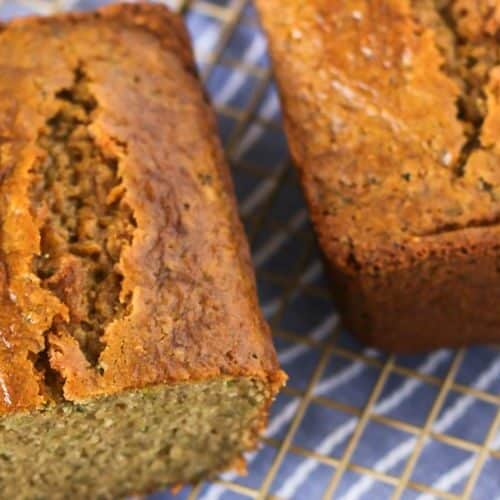All products are selected by our editorial team for quality. If you buy through our links, we may earn a small commission at no extra cost to you.
Gluten-Free Zucchini Bread is a moist, flavorful treat that offers a perfect balance of sweetness and a touch of spice.
It’s a popular option for those with gluten sensitivities or anyone looking for a healthier alternative to traditional bread.
The natural moisture from the zucchini keeps the bread soft and tender, making it a great snack or breakfast option.
Whether you’re new to gluten-free baking or just looking for a delicious new recipe, this gluten-free zucchini bread will quickly become a favorite.
Why make it gluten-free? By swapping out traditional wheat flour for a gluten-free alternative, you can enjoy all the flavors of this classic bread without worrying about gluten intolerance.
Plus, the recipe is easy to follow and can be customized to your taste with optional ingredients like nuts, raisins, or even chocolate chips.
In this post, you’ll learn how to make Gluten-Free Zucchini Bread from scratch, including all the ingredients and detailed instructions to ensure it turns out perfect every time.

Ingredients for Gluten-Free Zucchini Bread
To make this gluten-free zucchini bread, you’ll need a few basic ingredients, which you might already have in your pantry.
Here’s everything you’ll need to get started:
Gluten-Free Flour
The most important ingredient in any gluten-free recipe is the flour blend.
A good gluten-free flour mix, preferably one that includes rice flour, potato starch, and tapioca flour, works well for zucchini bread.
If you’re using a pre-made flour blend, ensure that it contains xanthan gum or guar gum, which helps give the bread structure and prevent it from becoming crumbly.
Zucchini
The star of the show!
You’ll need about two medium-sized zucchinis. Make sure to grate them finely.
You don’t need to peel the zucchini; the skin adds color and nutrition.
After grating, be sure to squeeze out any excess moisture to prevent the bread from becoming soggy.
Eggs
Eggs provide moisture and help bind the ingredients together. They also contribute to the structure of the bread.
If you need an egg-free option, you can substitute with flax eggs (1 tablespoon ground flaxseed mixed with 3 tablespoons water per egg).
Sugar
For sweetness, use granulated sugar, coconut sugar, or even a sugar substitute if you’re trying to reduce your sugar intake.
Adjust according to your sweetness preference.
Spices
A pinch of ground cinnamon is essential for that warm, comforting flavor.
If you’d like to add a little more depth, you can include a dash of nutmeg or cloves as well.
Baking Powder & Baking Soda
These leavening agents ensure that your bread rises properly and has the right texture.
Vanilla Extract
A splash of vanilla extract enhances the overall flavor of the zucchini bread and complements the spices.
Oil or Butter
Use vegetable oil, coconut oil, or melted butter.
Each option brings a slightly different flavor but all keep the bread moist and tender.
Optional Add-Ins
Feel free to personalize the recipe with optional ingredients like chopped walnuts, pecans, chocolate chips, or even raisins. These additions add texture and extra flavor to the bread.
Step-by-Step Instructions for Making Gluten-Free Zucchini Bread

Making Gluten-Free Zucchini Bread is easier than it sounds. Follow these steps carefully to create a loaf that is both moist and delicious.
Step 1: Prepare the Zucchini
Start by washing and drying the zucchinis. Using a box grater or a food processor, grate the zucchini finely.
You should have about 2 cups of grated zucchini.
Once grated, place the zucchini in a clean kitchen towel or paper towel and squeeze out any excess moisture.
This helps to prevent the bread from becoming too wet and soggy.
Step 2: Mix the Dry Ingredients
In a large bowl, combine the gluten-free flour, baking powder, baking soda, cinnamon, and any other dry spices you’re using. Whisk the ingredients together thoroughly to ensure they’re evenly distributed.
Step 3: Combine the Wet Ingredients
In a separate bowl, whisk the eggs, sugar, and vanilla extract.
Once these ingredients are mixed, add the oil (or melted butter).
Stir until the wet ingredients are well combined.
Step 4: Mix Wet and Dry Ingredients
Now, gradually add the dry ingredients into the wet ingredients, stirring gently.
Avoid overmixing at this stage, as overmixing can result in dense bread.
Just stir until the ingredients are well incorporated.
Step 5: Add the Zucchini and Optional Mix-Ins
Next, fold in the prepared zucchini.
Make sure the zucchini is evenly distributed throughout the batter.
If you’re adding any optional ingredients like nuts or chocolate chips, gently fold them in at this point.
Step 6: Bake the Bread
Preheat your oven to 350°F (175°C).
Grease and flour a loaf pan (or use parchment paper for easy removal).
Pour the batter into the pan and smooth out the top with a spatula.
Bake for 50-60 minutes, or until a toothpick inserted into the center comes out clean.
Baking times may vary slightly based on your oven, so start checking at around 50 minutes.
Step 7: Cool and Serve
Once your zucchini bread is fully baked, remove it from the oven and let it cool in the pan for 10 minutes.
Then, transfer the bread onto a wire rack to cool completely.
Slice it up once it’s cool and enjoy! For the best texture, let the bread rest for a few hours before slicing.
Tips for Perfect Gluten-Free Zucchini Bread
Making the perfect gluten-free zucchini bread requires a few extra steps and some attention to detail.
Here are some tips to help you achieve the best results:
1. Moisture Control
Zucchini has a high water content, which can make the bread soggy if not handled properly.
After grating the zucchini, be sure to squeeze out as much moisture as possible using a clean kitchen towel or paper towels.
This will help keep the bread from becoming too wet and ensure the right consistency.
2. Use a Good Gluten-Free Flour Blend
Not all gluten-free flours behave the same.
A pre-made gluten-free flour blend with a mix of rice flour, potato starch, and tapioca flour will work best for this recipe.
‘If you’re using a single gluten-free flour, like almond flour or coconut flour, be aware that you’ll need to adjust the recipe, as they behave differently.
3. Don’t Overmix the Batter
When mixing the dry and wet ingredients, be careful not to overmix. Overmixing can lead to a dense and tough texture.
Stir gently until everything is just combined, and then stop.
4. Check for Doneness Early
Gluten-free baked goods can sometimes take longer to cook than their traditional counterparts.
Start checking your bread at around 50 minutes with a toothpick. If it comes out clean or with just a few crumbs attached, the bread is done.
5. Let the Bread Cool Completely
Allow the zucchini bread to cool in the pan for at least 10 minutes before transferring it to a wire rack.
Cooling the bread before slicing ensures that it holds its shape and texture, rather than falling apart.
6. Store Properly for Freshness
Once your zucchini bread is cooled, store it in an airtight container.
If you want to keep it fresh for a longer period, wrap the bread tightly and store it in the refrigerator for up to 5 days.
You can also freeze slices for up to 3 months.
Variations of Gluten-Free Zucchini Bread
Gluten-free zucchini bread is versatile and can be customized to your taste. Here are some fun variations to try:
1. Chocolate Chip Zucchini Bread
For those who love a sweet, indulgent twist, add chocolate chips to your zucchini bread.
Semi-sweet, dark, or dairy-free chocolate chips are all great options.
Mix them into the batter along with the zucchini for a delicious chocolatey bite.
2. Nut-Free Zucchini Bread
If you’re allergic to nuts or prefer a nut-free option, simply omit any nuts or seeds from the recipe.
You can add an extra teaspoon of cinnamon or a handful of dried fruit (like raisins) to keep the texture interesting without the nuts.
3. Dairy-Free Zucchini Bread
To make this zucchini bread dairy-free, substitute the butter or milk for plant-based alternatives.
Use coconut oil or olive oil in place of butter, and any dairy-free milk (such as almond milk or oat milk) in place of cow’s milk.
4. Spice Up with Nutmeg or Cloves
If you love warm spices, consider adding ground nutmeg or cloves to the recipe along with the cinnamon.
Just a pinch of nutmeg or a sprinkle of ground cloves can elevate the flavor profile and give the bread a cozy, autumn-like taste.
5. Add Dried Fruit
For a fruity twist, try adding dried cranberries, raisins, or chopped dried apricots. These fruits add both sweetness and texture to the bread, balancing the savory elements of the zucchini.
6. Gluten-Free Banana-Zucchini Bread
If you’re craving even more moisture, try adding a mashed ripe banana to the batter.
The banana adds extra sweetness and makes the bread incredibly soft.
Simply substitute one medium-sized ripe banana for a portion of the zucchini, or use both for an extra fruity loaf.
Conclusion
Gluten-Free Zucchini Bread is a delightful and healthy option for anyone looking to enjoy a comforting treat without gluten.
With its moist texture, natural sweetness from zucchini, and endless possibilities for customization, this recipe is a keeper.
Whether you’re baking for dietary reasons or simply want to try something new, this zucchini bread is sure to become a favorite in your recipe collection. Plus, with a few easy tips and variations, you can make it your own.
So, gather your ingredients, follow the steps, and enjoy the delicious results. Don’t forget to share your creations with friends and family or leave a comment below with your own twists on the recipe.
Happy baking!
Frequently Asked Questions (FAQs)
1. Can I use frozen zucchini for this recipe?
Yes, you can use frozen zucchini for this recipe. However, be sure to thaw it completely and squeeze out all the excess moisture before adding it to the batter.
Frozen zucchini can sometimes release more water than fresh zucchini, so draining it properly is crucial to prevent the bread from becoming too soggy.
2. How can I make my gluten-free zucchini bread more moist?
To ensure the bread is extra moist, make sure to squeeze out the excess moisture from the zucchini before adding it to the batter.
Additionally, using oil (such as coconut oil or vegetable oil) instead of butter can contribute to a moister texture.
If you find the bread a little dry, try adding an extra egg or using a bit of applesauce for added moisture.
3. Can I substitute the sugar with a sugar alternative?
Yes, you can substitute sugar with alternatives such as coconut sugar, honey, maple syrup, or stevia.
Keep in mind that some alternatives may affect the texture or sweetness level, so you may need to adjust quantities.
For instance, if using a liquid sweetener like honey or maple syrup, you may need to reduce the amount of other liquids in the recipe.
4. How long does gluten-free zucchini bread last?
Gluten-free zucchini bread can last up to 5 days when stored in an airtight container at room temperature.
If you want to extend its shelf life, refrigerate it, or freeze individual slices for up to 3 months. Be sure to wrap the bread tightly to maintain its freshness.
5. Can I make gluten-free zucchini bread without eggs?
Yes, you can make this recipe egg-free.
Use flax eggs as a substitute: mix 1 tablespoon of ground flaxseed with 3 tablespoons of water for each egg.
Let the mixture sit for about 5 minutes to thicken before adding it to the batter.
This works well and provides similar binding and moisture as eggs.

Gluten-Free Zucchini Bread
Equipment
- 1 Loaf Pan (8.5 x 4.5 inches or 9 x 5 inches)
- 1 box grater or food processor (for grating zucchini)
- 1 Mixing Bowl (for dry ingredients)
- 1 Mixing Bowl (for wet ingredients)
- 1 whisk (for mixing dry ingredients)
- 1 Spatula (for folding in ingredients)
- 1 Measuring cups and spoons
Ingredients
- 2 cups 240g Gluten-Free Flour (rice flour, potato starch, tapioca flour blend)
- 2 medium Zucchini grated
- 2 large Eggs
- 1 cup 200g Granulated Sugar (or coconut sugar)
- 1 tsp Vanilla Extract
- 1/2 cup 120ml Vegetable Oil (or melted coconut oil)
- 1 tsp Baking Powder
- 1 tsp Baking Soda
- 1 tsp Ground Cinnamon
- 1/4 tsp Salt
- Optional: 1/2 cup 60g Chocolate Chips or 1/2 cup (60g) Chopped Nuts
Instructions
Preheat Oven and Prepare Pan
- Preheat your oven to 350°F (175°C).Grease and flour a loaf pan (8.5 x 4.5 inches or 9 x 5 inches) or line it with parchment paper for easy removal.
Prepare Zucchini
- Grate the zucchini using a box grater or food processor. After grating, place the zucchini in a clean kitchen towel or paper towels and squeeze out any excess moisture. You should have about 2 cups of grated zucchini.
Mix Dry Ingredients
- In a large bowl, whisk together the gluten-free flour, baking powder, baking soda, cinnamon, and salt.
Mix Wet Ingredients
- In a separate bowl, whisk the eggs, sugar, and vanilla extract. Add the vegetable oil (or melted coconut oil) and mix until well combined.
Combine Wet and Dry Ingredients
- Gradually add the dry ingredients into the wet ingredients, mixing gently with a spatula. Stir until just combined—don’t overmix.
Add Zucchini and Optional Mix-ins
- Fold in the grated zucchini and any optional mix-ins (such as chocolate chips or nuts).
Bake the Bread
- Pour the batter into the prepared loaf pan and smooth the top with a spatula. Bake for 50-60 minutes, or until a toothpick inserted into the center comes out clean.
Cool and Slice
- Let the zucchini bread cool in the pan for 10 minutes before transferring to a wire rack to cool completely. Slice once cooled, and enjoy!
Notes
- Moisture Control: Be sure to squeeze out as much moisture as possible from the zucchini to avoid a soggy bread.
- Flour Options: If you prefer a different gluten-free flour, you can use a mix of almond flour or coconut flour, but you may need to adjust the liquid content of the recipe.
- Storage: Store the zucchini bread in an airtight container at room temperature for up to 5 days, or refrigerate for longer shelf life.
- Freezing: This bread freezes well. Wrap individual slices tightly in plastic wrap and store in a freezer-safe bag for up to 3 months.

